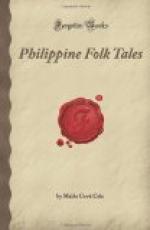NOTES
[1] This incident is strikingly similar to the story in North American folk-lore of the maiden captured and carried upward by a vine. Several other points of likeness appear in the lore of Malaysia, Polynesia, and America.
[2] See Preface, p. vii.
[3] This incident is unique so far as American or European folk-lore is concerned, yet it is common in Tinguian tales, while similar stories are found among the neighboring Ilocano and Igorot tribes of the Philippines, as well as in Borneo, Java, and India.
[4] The belief that beauty is capable of radiating great light is not peculiar to Tinguian tales, for it is also found in the Malay legends and in those of India. It is not impossible that they had a common origin.
[5] The betel-nut is the nut of the areca palm. It is prepared for chewing by being cut into quarters, each piece being wrapped in betel-leaf spread with lime. It produces a blood-red spittle which greatly discolors the teeth and lips, and it is used extensively throughout the Philippines. While it appears to have been in common use among the Tinguian at the time these stories originated, it has now been displaced by tobacco, except at ceremonies when it is prepared for chewing; it is also placed on the animals offered for sacrifice to the spirits. Throughout the tales great significance is given to the chewing of betel-nuts before names are told or introductions given, while from the quids and spittle it appears to have been possible to foretell events and establish relationships.
[6] Compare with the story of Phaeton in Bulfinch, The Age of Fable, p. 50.
[7] The Tinguian have no calendar, but reckon time by the recurrence of the moon.
[8] It is the present custom of the Tinguian to make numerous ceremonies for the spirits. These vary in length from a few hours to seventeen days. During this period animals are slaughtered, small houses are built, mediums deliver messages from the spirits, and there is much feasting and dancing.
[9] When ripe, the betel-nut is covered with a golden husk, and it is possibly because of this that they were said to be covered with gold. The present-day Tinguian, in place of sending the betel-nut, sends a small piece of gold to any relative or friend whom he specially wishes to induce to attend a ceremony.




